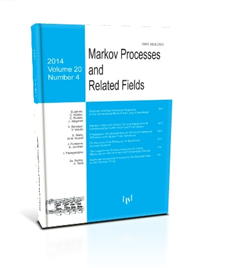Small Time Almost Sure Comparisons Between a L\'{e}vy Process and its Maximal Jump Processes
R. Maller
2016, v.22, Issue 4, 775-806
ABSTRACT
Small time" (as $t\dto 0$) almost sure (a.s.) asymptotic comparisons between a L\'evy process $X=(X_t)_{t\ge 0}$ and its maximal jump processes are studied, with the aim of delineating how much the process is influenced by its large jumps. The process may be comparable in size with its large jumps, or, alternatively, dominate them. $X$ may even be replaced in an a.s.\ sense by its largest jump under certain conditions: it's possible to have $X_t/\sup_{0<s\le t}\Delta X_s$ and/or $X_t/\sup_{0<s\le t}|\Delta X_s|$ converging a.s.\ to 1 as $t\dto 0$. Necessary and sufficient conditions in terms of the canonical measure of $X$ are obtained for each of these kinds of behaviour; they correspond to a relatively mild singularity in the measure at 0. At the other extreme are cases when $X$ dominates its maximal jump processes in the sense that, for example,
$|X_t|/\sup_{0<s\le t}|\Delta X_s|$
diverges to $\infty$ a.s.\ as $t\dto 0$. The typical requirement here is that $X$ be of bounded variation with non-zero drift.
%% correspond to a stronger singularity in the measure at 0. An important component in the analyses is the way the largest positive and negative jumps interact with each other.
The analysis allows for the possibility of ties in large jump sizes.
Keywords: Levy process, maximal jump processes
COMMENTS
Please log in or register to leave a comment

